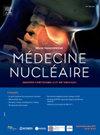Toward a reproductive radiolabeling with {Al18F}2+ complex?
IF 0.2
4区 医学
Q4 PATHOLOGY
Medecine Nucleaire-Imagerie Fonctionnelle et Metabolique
Pub Date : 2025-02-01
DOI:10.1016/j.mednuc.2024.12.052
引用次数: 0
Abstract
Objectives
Fluoride-18 is the most widely used radionuclide for PET imaging but radiolabeling generally requires drastic conditions (high temperature or basic medium) and time-consuming purification by HPLC. Attractiveness of radiometallation has led to develop, in 2009, a radiolabeling strategy using {Al18F}2+ complex to mimic a radiometal. Since then, many groups described various radiolabeling conditions, but radiochemical yields are disparate, and some parameters seem unclear. That is why we propose a comprehensive comparison of the radiolabeling parameters in order to have an optimal and reproductive methodology for future clinical developments.
Methods
With the aim to obtain probes usable for pretargeting strategies or coupling with peptides, we selected NOTA-PEGn-X (X = N3 or Tz and n = 0, 4, 11) precursors as model compounds for optimization studies. Manually radiolabeling of NOTA precursors with {Al18F}2+ complex were focused on the following key points: (i) conditioning, and elution of the QMA cartridge (0.9% NaCl and/or 0.4 M KHCO3, 100–200 μL) for the purification of the fluoride-18; (ii) amount of NOTA-precursors compared to Al3+ (1–10 molar equivalents); (iii) use of NaOAc buffer (pH 4) alone or with organic co-solvent (ACN or EtOH, 200–700 μL) at 50–90 °C for 5–20 min for radiolabeling step; (iv) geometry of the reaction vessel; and (v) cartridge for purification step. Radiosyntheses were then automated on SynChrom R&D EVOI module where unexpected further optimisations were required. Complexation efficiency, identity of the radiolabeled probes and radiochemical purities were determined by radio-TLC and radio-RP-HPLC.
Results
[18F]AlF-NOTA-PEGn-X were obtained in 50–80% (dc) radiochemical yield (RCY) after incubation heating of the appropriated precursors, 2 mM AlCl3.6H20 and purified 18F- in 0.9% NaCl/EtOH mixture at 90 °C for 15 min, followed by SPE purification with Oasis HLB cartridge. The overall procedure time was only 30 min. According to automated method, RCY are ranging from 30% to 35% in 40–45 min. In each case, radiolabeled probes were obtained with excellent radiochemical purities (> 99%).
Conclusion
Among all the conditions described in the literature, we were able to determine optimal parameters for tradiolabeling. We have also demonstrated that, despite the optimization of each parameter, similar results cannot be obtained with automated radiosynthesis, which could be a limitation for this methodology.
求助全文
约1分钟内获得全文
求助全文
来源期刊
CiteScore
0.30
自引率
0.00%
发文量
160
审稿时长
19.8 weeks
期刊介绍:
Le but de Médecine nucléaire - Imagerie fonctionnelle et métabolique est de fournir une plate-forme d''échange d''informations cliniques et scientifiques pour la communauté francophone de médecine nucléaire, et de constituer une expérience pédagogique de la rédaction médicale en conformité avec les normes internationales.

 求助内容:
求助内容: 应助结果提醒方式:
应助结果提醒方式:


